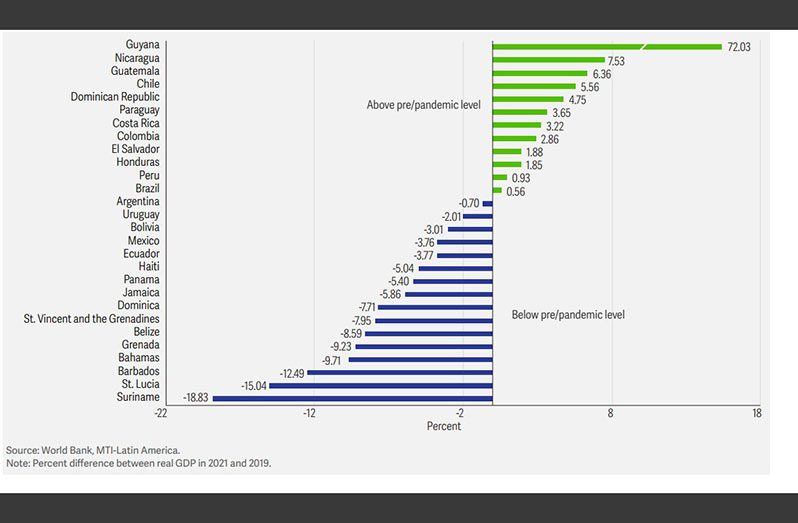–records highest cumulative economic growth in Caribbean, Latin American region during pandemic period
GUYANA, though not exempt from the effects of the COVID-19 pandemic, has managed to overcome the challenges that accompany this dreaded malady, recording the highest cumulative economic growth in the Caribbean and Latina American region, according to the World Bank.
Having considered the economic performance of countries during the period 2019-2021, the World Bank determined that Guyana recorded cumulative economic growth of 72.03 per cent.
The closest nation behind Guyana is Nicaragua, which recorded cumulative economic growth of 7.53 per cent.
Guyana’s prospects remain positive, as it was reported that the country, driven by increased production in Guyana’s burgeoning oil and gas sector and projected improvements in the performances of traditional mining and construction, is on course to growing by 47.5 per cent and 7.7 per cent in the non-oil economy, in 2022.
This economic performance will follow growth rates of 19.9 per cent and 4.6 per cent recorded at the end of 2021, despite the persistence of COVID-19, as well as the impact of floods. With this rate of overall growth, Guyana is likely to be amongst the fastest growing economies worldwide.
The resilience of the country’s economy is being demonstrated as the country continues to progress despite grappling with the effects of the COVID-19 pandemic, and, more recently, Russia’s invasion of Ukraine.
“Our economy is becoming stronger; it is rebounding from the two-year-long effects of the coronavirus pandemic. Businesses, both local and foreign, are capitalising on the unfolding opportunities and, in the process, generating jobs and providing incomes for our citizens,” President Dr. Irfaan Ali had said in a recent address to the nation.
Based on Budget 2022- the country’s largest to date- the government intends to enhance its approach to stimulating growth in various economic sectors.
The government’s action comes at a time when the World Bank is reporting that economies in Latin America and the Caribbean are on track to recover from the COVID-19 crisis.
Although the projections are promising for this region, the World Bank said: “… the scars of the pandemic remain and the need for a more dynamic, inclusive and sustainable growth is ever more urgent.”
According to the international financial institution, following a 6.9 per cent rebound in 2021, regional Gross Domestic Product (GDP) is expected to grow 2.3 per cent this year and a further 2.2 per cent in 2023, with most countries reversing the GDP losses from the pandemic crisis.
“However, these modest projections place regional performance among the lowest in the world at a time when the region faces important uncertainties as new variants of the virus may appear, inflation pressures mount and the war in Europe threatens the world recovery. In fact, regional growth projection has been revised downward by 0.4 per cent after the Russian invasion of Ukraine,” the World Bank wrote.
As a result of COVID-19 in particular, poverty rates rose to 27.5 per cent in 2021 and are still above their pre-COVID levels of 25.6 per cent, while learning losses could lead to a 10 per cent decrease in future earnings for millions of school-aged children.
On the positive side, however, vaccination is widespread across the region, firms are again hiring, and schools are reopening.
To avoid returning to the low growth rates of the 2010s, countries in the region need to examine long-delayed structural reforms and seize the opportunities offered by a greening world economy, the World Bank advised.
GREAT UNCERTAINTY
“We are in a global context of great uncertainty that could impact the post-pandemic recovery. In the long term, however, the challenges of climate change will be even more pressing, which forces us to urgently move to a growth agenda that is greener, more inclusive and that raises productivity,” Vice President for Latin America and the Caribbean at the World Bank, Carlos Felipe Jaramillo, said.
According to the report, growth advancing reforms in infrastructure, education and innovation remain paramount, and key investments should be financed through more efficient spending and revenue mobilisation. But these much-needed reforms should respond to major forces shaping the global economy, including climate change.
Over the last two decades, the report highlighted, countries in Latin America and the Caribbean lost the equivalent of 1.7 per cent of a year’s GDP due to climate related disasters and up to 5.8 million people could be pushed into extreme poverty in the region by 2030.
Agriculture, the bank said, is likely to be hit hard, with crop yields decreasing in virtually all countries, and energy generation stability will be undermined by changes in the hydrological cycle.
“LAC has tremendous green comparative advantages, offering opportunities for new industries and exports. It has vast potential in renewable energy, large resources of lithium and copper used in green technologies, and a rich natural capital, all increasingly valued in a world where global warming and energy security are moving center stage”, Chief Economist for Latin America and the Caribbean at the World Bank, William Maloney, said.
He added: “However, both adapting to climate change and leveraging these opportunities for diversified and sustained growth will require improving the region’s capabilities to identify, adapt and implement new technologies.”



.jpg)










